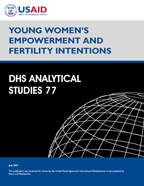There is no printed copy available to order.
Abstract:
Fertility intentions among young women are
important drivers of future fertility trends.
Among adults, women’s empowerment has been
linked to the ability to realize fertility
intentions. This study examines associations
between young women’s empowerment and
fertility intentions using data on women age
15-49 from 10 Demographic and Health Surveys.
One challenge to assessing empowerment among
youth is that most measures of empowerment
apply only to adults and, in the case of
fertility, married adults. We developed a
Youth Empowerment (YE) scale with six
domains, suitable for use with youth
regardless of marital or school status or
age.
This study first describes patterns of YE and
two measures of fertility intentions: ideal
number of children and use/intention to use
contraception. We disaggregate by age group,
marital status, and school status since both
fertility intention outcomes and empowerment
are likely to manifest differently across
these groups. The study then uses
multivariable regression analysis to assess
the association between YE and fertility
intentions, controlling for these and other
factors.
YE varies by country, measuring lowest in
Mali (13% in the highly empowered tercile)
and highest in the Philippines (81% in this
tercile). YE is lowest among the youngest
women (eight of ten countries) and currently
married young women (all ten countries). YE
is highest among never married women in five
countries, but highest among formerly married
women in the other five countries examined.
Similarly, in five of the countries YE is
highest among out-of-school youth, while it
is highest among in-school youth in another
four countries.
We find a significant, negative bivariate
association between young women’s empowerment
and ideal number of children in all ten study
countries, indicating that as women’s
empowerment increases, ideal number of
children decreases. This association remains
significant with multivariable analysis in
six countries.
Young women’s empowerment is significantly
positively associated with use of
contraception and, among non-users, intention
to use contraception in eight of ten
countries. After controlling for other
factors, these associations remain
significant in five and eight countries,
respectively. The largest differences are
generally between the high YE and medium YE
categories. These findings suggest the
importance of programmatic and policy
interventions that build and maintain young
women’s empowerment, while also facilitating
achievement of their fertility intentions.
 Young Women's Empowerment and Fertility Intentions (PDF, 1344K)
Young Women's Empowerment and Fertility Intentions (PDF, 1344K)
 Young Women's Empowerment and Fertility Intentions (AS77) - Analysis Brief
Young Women's Empowerment and Fertility Intentions (AS77) - Analysis Brief
